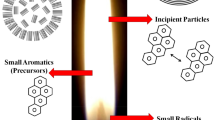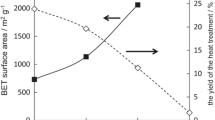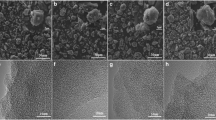Abstract
To investigate the influence of expansion pretreatment for materials on carbon structure, activated carbons (ACs) were prepared from corncob with/without expansion pretreatment by KOH activation, the structure properties of which were determined based on N2 adsorption isotherm at 77 K. The results show that the expansion pretreatment for corncobs is beneficial to the preparation of ACs with high surface area. The specific surface area of the AC derived from corncob with expansion pretreatment (AC-1) is 32.5% larger than that without expansion pretreatment (AC-2). Furthermore, to probe the potential application of corncob-based ACs in electric double-layer capacitor (EDLC), the prepared ACs were used as electrode materials to assemble EDLC, and its electrochemical performance was investigated. The results indicate that the specific capacitance of AC-1 is 276 F/g at 50 mA/g, which increases by 27% compared with that of AC-2 (217 F/g). As electrode materials, AC-1 presents a better electrochemical performance than AC-2, including a higher voltage maintenance ratio and a lower leakage current.
Similar content being viewed by others
References
Zhang Xiong, Ji Liyan, Zhang Shichao et al. Synthesis of a novel polyaniline intercalated layered manganese oxide nanocomposite as electrode material for electrochemical capacitor[J]. Journal of Power Sources, 2007, 173(2): 1017–1023.
Lee S I, Mitani S, Park C W et al. Electric double-layer capacitance of microporous carbon nano-spheres prepared through precipitation of aromatic resin pitch [J]. Journal of Power Sources, 2005, 139(1/2): 379–383.
Zhu Yudong, Hu Haoquan, Li Wencui et al. Cresolformaldehyde based carbon aerogel as electrode materials for electrochemical capacitor[J]. Journal of Power Sources, 2006, 162(1): 738–742.
Zhang Lin, Liu Hongbo, Wang Ming et al. Structure and electrochemical properties of resorcinol-formaldehyde polymer-based carbon for electric double-layer capacitors[ J]. Carbon, 2007, 45(7): 1439–1445.
Ismanto A E, Wang S, Soetaredjo F E et al. Preparation of capacitor’s electrode from cassava peel waste[J]. Bioresource Technology, 2010, 101(10)}: 3534–35
Li Xueliang, Han Changlong, Chen Xiangying et al. Preparation and performance of straw based activated carbon for supercapacitor in non-aqueous electrolytes[J]. Microporous and Mesoporous Materials, 2010, 131(1–3): 303–309.
Lee S G, Park K H, Shim W G et al. Performance of electrochemical double layer capacitors using highly porous activated carbons prepared from beer lees[J]. Journal of Industrial and Engineering Chemistry, 2011, 17(3): 450–454.
Senthilkumar S T, Senthilkumar B, Balaji S et al. Preparation of activated carbon from sorghum pith and its structural and electrochemical properties[J]. Materials Research Bulletin, 2011, 46(3): 413–419.
Wang Meixian, Wang Chengyang, Chen Mingming et al. Preparation of high-performance activated carbons for electric double layer capacitors by KOH activation of mesophase pitches[J]. New Carbon Materials, 2010, 25(4): 285–290.
Li Limin, Liu Enhui, Li Jian et al. A doped activated carbon prepared from polyaniline for high performance supercapacitors[ J]. Journal of Power Sources, 2010, 195(5): 1516–1521.
Wang Hongqiang, Zhong Yulan, Li Qingyu et al. Cationic starch as a precursor to prepare porous activated carbon for application in supercapacitor electrodes[J]. Journal of Physics and Chemistry of Solids, 2008, 69(10): 2420–2425.
Jeong E Y, Jung M J, Cho S H et al. Surface and electrochemical properties of amino-fluorinated activated carbon[ J]. Colloids and Surfaces A: Physicochemical and Engineering Aspects, 2011, 377(1–3): 243–250.
Barpanda P, Fanchini G, Amatucci G G et al. Structure, surface morphology and electrochemical properties of brominated activated carbons[J]. Carbon, 2011, 49(7): 2538–2548.
Zhang Chuanxiang, Zhang Rui, Xing Baolin et al. Effect of pore structure on the electrochemical performance of coalbased activated carbons in non-aqueous electrolyte[J]. New Carbon Materials, 2010, 25(2): 129–133.
Wang Yansu, Wang Chengyang, Guo Chunyu et al. Influence of carbon structure on performance of electrode material for electric double-layer capacitor[J]. Journal of Physics and Chemistry of Solids, 2008, 69(1): 16–22.
Laine J, Yunes S. Effect of the preparation method on the pore size distribution of activated carbon from coconut shell[J]. Carbon, 1992, 30(4): 601–604.
Molina-Sabio M, Rodriguez-Reinoso F, Caturla F et al. Porosity in granular carbons activated with phosphoric acid[J]. Carbon, 1995, 33(8): 1105–1113.
Cao Qing, Xie Kechang, Lu Yongkang et al. Process ef fects on activated carbon with large specific surface area from corn cob[J]. Bioresource Technology, 2006, 97(1): 110–115.
Tseng R L, Tseng S K, Wu F C. Preparation of high surface area carbons from corncob with KOH etching plus CO2 gasification for the adsorption of dyes and phenols from water[J]. Colloids and Surfaces A: Physicochemical and Engineering Aspects, 2006, 279(1–3): 69–78.
Su Wei, Zhou Li, Zhou Yaping. Preparation of microporous activated carbon from coconut shells without activating agents[J]. Carbon, 2003, 41(4): 861–863.
El-Hendawy Abdel-Nasser A, Samra S E, Girgis B S. Adsorption characteristics of activated carbons obtained from corncobs[J]. Colloids and Surfaces A: Physicochemical and Engineering Aspects, 2001, 180(3): 209–221.
Wang Yuxin, Liu Bingsi, Zheng Chao. Preparation and adsorption properties of corncob-derived activated carbon with high surface area[J]. Journal of Chemical and Engineering Data, 2010, 55(11): 4669–4676.
Brunauer S, Emmett P H, Teller E. Adsorption of gases in multimolecular layers[J]. Journal of the American Chemical Society, 1938, 60(1): 309–319.
Rangarajan B, Lira C T, Subramanian R. Simplified local density model for adsorption over large pressure ranges[J]. AIChE Journal, 1995, 41(4): 838–845.
Cazorla-Amorós D, Alcañiz-Monge J, Linares-Solano A. Characterization of activated carbon fibers by CO2 adsorption[ J]. Langmuir, 1996, 12(11): 2820–2824.
Worasuwannarak N, Sonobe T, Tanthapanichakoon W. Pyrolysis behaviors of rice straw, rice husk, and corncob by TG-MS technique[J]. Journal of Analytical and Applied Pyrolysis, 2007, 78(2): 265–271.
Hu C C, Wang C C. Improving the utilization of ruthenium oxide within thick carbon-ruthenium oxide composites by annealing and anodizing for electrochemical supercapacitors[J]. Electrochemistry Communications, 2002, 4(7): 554–559.
Alvarez S, Blanco-Lopez M C, Miranda-Ordieres A J et al. Electrochemical capacitor performance of mesoporous carbons obtained by templating technique[J]. Carbon, 2005, 43(4): 866–870.
Fang B Z, Binder L. A novel carbon electrode material for highly improved EDLC performance[J]. Journal of Physical Chemistry B, 2006, 110(15): 7877–7882.
Ju Y W, Choi G R, Jung H R et al. Electrochemical properties of electrospun PAN/MWCNT carbon nanofibers electrodes coated with polypyrrole[J]. Electrochimica Acta, 2008, 53(19): 5796–5803.
Conway B E. Electrochemical Supercapacitors: Scientific Fundamentals and Technological Applications[M]. Kluwer Academic Plenum Publisher, New York, 1999.
Li Na, Wang Xianyou, Wei Jianliang et al. Template synthesis of mesoporous carbon and its application in supercapacitors[J]. Journal of Central South University (Science and Technology), 2009, 40(3): 601–607.
Zhao Shuo, Wang Chengyang, Chen Mingming et al. Potato starch-based activated carbon spheres as electrode material for electrochemical capacitor[J]. Journal of Physics and Chemistry of Solids, 2009, 70(9): 1256–1260.
Author information
Authors and Affiliations
Corresponding author
Additional information
Supported by National Natural Science Foundation of China (No. 50902102 and No. 51172160).
WANG Yuxin, born in 1974, female, Dr, lecturer.
Rights and permissions
About this article
Cite this article
Wang, Y., Liu, B., Shi, Z. et al. Application of corncob-based activated carbon as electrode material for electric double-layer capacitors. Trans. Tianjin Univ. 18, 217–223 (2012). https://doi.org/10.1007/s12209-012-1799-1
Accepted:
Published:
Issue Date:
DOI: https://doi.org/10.1007/s12209-012-1799-1




